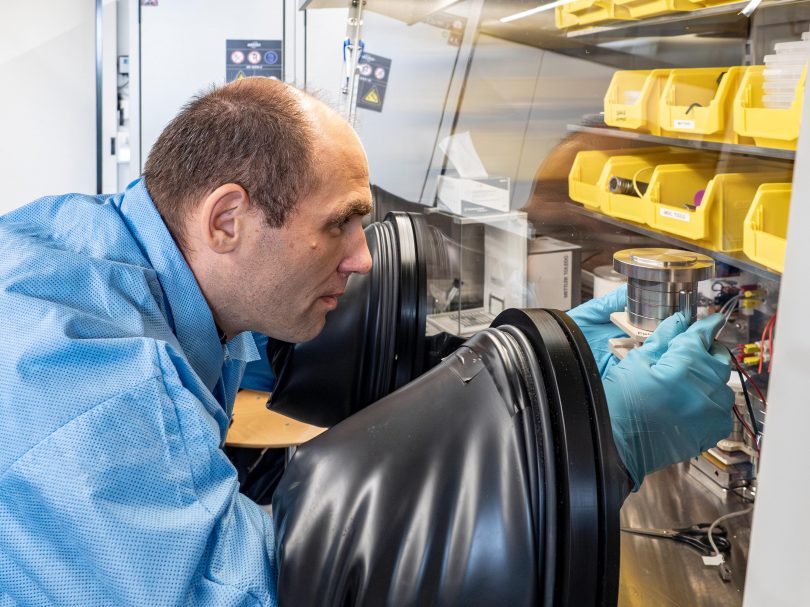[Empa] – What are the hallmarks of a good battery? Is it its capacity? How fast it charges? Or its price? The answer depends on where the battery is used, says Empa researcher Kostiantyn Kravchyk. In the Functional Inorganic Materials Group, led by Maksym Kovalenko and part of Empa’s Laboratory for Thin Films and Photovoltaics, the scientist is developing new materials to make tomorrow’s batteries more powerful and faster – or more cost-effective.
Two areas of application for rechargeable batteries are crucial for the transition to renewable energy. One is electromobility; the other is so-called stationary storage, which stores electricity from renewable energy sources such as wind and sun. Batteries for electric cars must be compact and lightweight, have a high capacity and charge as quickly as possible. Stationary batteries may take up more space, but they are only cost-effective if they are as cheap as possible.
No simple task
In essence, every battery consists of a cathode, an anode and an electrolyte. In conventional lithium-ion batteries, the anode is made of graphite, and the cathode material is a mixed oxide of lithium and other metals, such as lithium cobalt(III) oxide. The electrolytes are used as transmitters of lithium ions from the cathode to the anode and back, depending on whether the cell is being charged or discharged.
When it comes to batteries for electromobility, a high energy density is required. “With an anode made of pure metallic lithium instead of graphite, we could store many times more energy in a cell of the same size,” says Kravchyk. However, the lithium is not stripped and deposited evenly when the cell is charged and discharged. This results in the formation of so-called dendrites: branched structures of metallic lithium that can short-circuit the battery.
One way to slow down the growth of dendrites is to use solid electrolytes. In so-called solid-state batteries, instead of a liquid, a solid layer of material conducts the lithium ions from the cathode to the anode and back.
The requirements for the electrolyte material are high. “People talk about charging batteries within ten to fifteen minutes,” Kravchyk explains. “That requires a very high current density, at which dendrites form even in solid-state batteries.” Current density is the ratio of the current to the area through which it flows. A further issue is that the uneven stripping and deposition of lithium creates voids at the boundary between the electrode and the solid electrolyte, reducing the available contact area and further increasing the current density.
One material, two layers
As part of the Fraunhofer ICON (International Cooperation and Networking) funding program, Kravchyk and other Empa researchers have now refined a promising solid electrolyte. The material, lithium lanthanum zirconium oxide, or LLZO for short, has high ionic conductivity and chemical stability – ideal properties for use in batteries.
“We have made a bilayer LLZO membrane consisting of a dense and a porous layer,” says Kravchyk. If lithium is stored in the pores, a very large contact area is created between the lithium and the electrolyte, and the current density remains low. The dense layer ensures that no dendrites can grow to the other electrode and cause a short circuit. The researchers have also thought about cost-effectiveness: They have developed a simple, inexpensive and scalable process to produce the bilayer membranes.
Inexpensive iron instead of costly cobalt
The researchers took a very different approach in a project involving stationary storage of renewable energy. “The most important metric for stationary storage is the price,” Kravchyk explains. The lithium-ion batteries used for stationary storage today are comparatively expensive. “That’s why most of stationary storage needs are still met by pump storage hydropower technology, even though it has a very low energy density compared to batteries,” the researcher continues.
One of the biggest cost drivers for stationary lithium-ion batteries are the materials used to manufacture them. In addition to lithium, cobalt and nickel are needed for the cathode. The search for better cathode materials quickly led the researchers to one of the most common elements in the Earth’s crust: iron.
For their cathode, the researchers combined the inexpensive metal with fluoride in the form of iron(III) hydroxyfluoride. “Previous approaches to making a battery based on iron fluorides relied on chemical conversion,” Kravchyk explains. This involves converting iron ions into metallic iron. “This process is not very stable,” the researcher states. “Ideally, the ions simply move from one pole to the other without undergoing major structural transformations.”
A challenge for the researchers, since fluorides have poor conductivity, both for electrons and for lithium ions. But Kravchyk’s team has the solution: Using a simple and inexpensive process, they have given their iron(III) hydroxyfluoride a particular crystalline structure. This so-called pyrochlore structure contains channels inside it that conduct lithium ions.
“We were able to achieve comparable performance at a much lower price with our battery,” Kravchyk says. “We are totally surprised that hardly anyone has explored to develop the low-cost synthesis of this promising material until now.”
- H Zhang, R Dubey, M Inniger, F Okur, R Wullich, A Parrilli, DT Karabay, A Neels, KV Kravchyk, MV Kovalenko; Ultrafast-sintered self-standing LLZO membranes for high energy density lithium-garnet solid-state batteries; Cell Reports Physical Science (2023); doi: 10.1016/j.xcrp.2023.101473
- JF Baumgärtner, M Wörle, CP Guntlin, F Krumeich, S Siegrist, V Vogt, DC Stoian, D Chernyshov, W van Beek, KV Kravchyk, MV Kovalenko; Pyrochlore-Type Iron Hydroxy Fluorides as Low-Cost Lithium-Ion Cathode Materials for Stationary Energy Storage; Advanced Materials (2023); doi: 10.1002/adma.202304158





